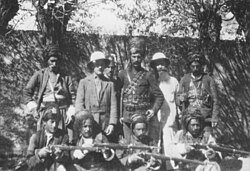Revolt
By summer 1918, Simko had established his authority over the regions west of Lake Urmia. [23] In 1919, Simko organized an army of 20,000 Kurds and managed to secure a self-governed area in northwestern Iran, centered in the city of Urmia. Simko's forces had been reinforced with several hundred soldiers and mercenaries from the Ottoman Empire, including Kurdish deserters and nationalists. [11] After taking over Urmia, Simko appointed Teymur Agha Shikak as the governor of the city. Later, he organized his forces to fight the Iranian army in the region and managed to expand the area under his control to the nearby towns and cities such as Mahabad, Khoy, Miandoab, Maku and Piranshahr in a series of battles.
In March 1921, Simko defeated the Iranian army under Zafar al-Dowleh (later Brigadier General Hasan Muqaddam) at Tasuj, north of Lake Urmia.
In September 1921, a detachment led by Hasan Arfa, which was reinforced from Tehran to Tabriz, was attacked by Simko and his 4,000 men. The detachment was completely defeated and half of the army died.
In the battle of Gulmakhana, Kurdish forces under the command of Simko Shikak took control over Gulmakhana and the Urmia-Tabriz road from Iranian forces. Simko ordered his advisor and commander-in-chief of the armed forces, Amar Khan Shikak, to attack the enemy forces. Amar Khan, along with an armed force and 200 warriors, destroyed enemy positions in the battle of Shekar Yazi and killed Amir Arshad. [24] In the battle of Savujbulak, Reza Shah, dispatched Khaloo Qurban to counter Kurdish expansion, but he was defeated and killed by Simko's forces in 1922. In the battle for the conquest of Mahabad (then named Savoujbolagh Mokri), Simko himself commanded his forces with the help of Seyyed Taha Shamzini. After a tough battle in October 1921, Iranian forces were defeated and their commander Major Malakzadeh along with 600 Iranian Gendarmeries was killed. Simko also conquered Maragheh and encouraged the Lurs tribes of western Iran to revolt.
At this time, the government in Tehran tried to reach an agreement with Simko on the basis of limited Kurdish autonomy. [25] Simko had further organized a Kurdish army, which grew stronger and stronger. Since the central government could not control his activities, he continued to expand the areas of western Iran under his control. By 1922, the cities of Baneh and Sardasht were under his administration. [26]
In the battle of sari Taj in 1922, Simko's forces could not resist the Iranian Army's onslaught in the region of Salmas and were finally defeated and the castle of Chari, where Simko's forces were camping, was occupied. The strength of the Iranian Army force dispatched against Simko was 10,000 soldiers. [27] Simko and one thousand of his mounted soldiers, took refuge in what was now Turkey, where they were forced to lay down their weapons.
Aftermath
By 1926, Simko had regained control of his tribe and begun another rebellion. [10] When the army engaged him, half of his troops betrayed him to the tribe's previous leader and Simko fled to Iraq. [10]
In 1930, the commander of the Iranian Army, General Hassan Muqaddam sent a letter to Simko, who was residing in the village of Barzan, and invited him for a meeting in the town of Oshnaviyeh. After consulting with his friends, Simko along with Khorshid Agha Harki went to Oshnaviyeh and were invited to the house of the local army commander, Colonel Norouzi, and were told to wait for the Iranian general. Colonel Norouzi convinced Simko to go to the outskirts of the town to welcome the general's arrival. However, this was a trap, and Simko was ambushed and killed on the evening of June 30, 1930.

